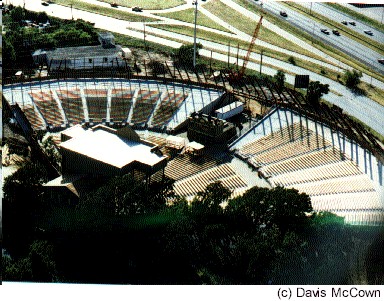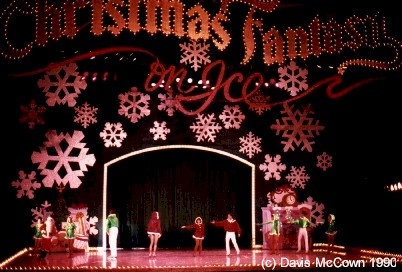Last Year Operated: 1982
Section: Goodtimes Square
Manufacturer:
Other Names and Nicknames:
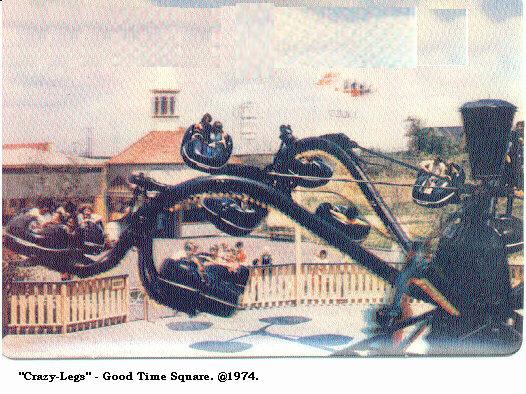
The Unofficial History of Six Flags Over Texas

The Rotoriculous was built at the back of Good Times Square between the Bumper Cars and the Crazy Legs. The Rodoriculous was designed from a typical “Himalaya” style ride, with a chain of seats strung together to form a circle around the edge of the ride.
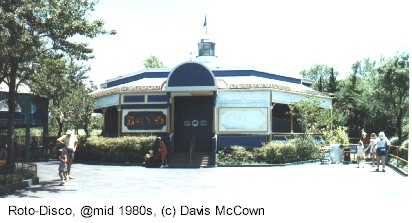
The Rotoriculous differed from other “Himalaya” style rides, however, in that it was completely indoors. It was housed in a small building with just enough room for the ride and control station. In addition to the ride, the room was equipped with special audio and visual effects, including the symbol of the seventies, a large disco mirror ball.
As the ride started, the cars moved up and down and they circled the track. As the ride slowly started forward, a recorded narration began, telling the story of the invention (the ride) and its intended purpose.
Within a few moments, however, the narrator announced that something had gone wrong, as which time the ride began to rotate backwards at much greater speed. Simultaneously with the ride changing directions, the sound became more chaotic, random slides were flashed at high speeds on the sides of the building, and other flashing lights went off.
Eventually, things were brought back to “normal”, the ride slowed down and the bizarre lights and sounds terminated. As the years past, the narrator was removed and the slides and lights became more random. Eventually, the ride was renamed the Roto-disco and the disco ball became the centerpiece effect.
The park opened the Superman tower ride for 2003. The ride, a three leg free-fall tower, stands 325-feet tall from the ground to the top of the ten-foot tall US flag mounted on the structure. It is one of the world’s tallest free falls rides. At the time that it was installed, it was the tallest structure in the park when measured to the top of the American flag.
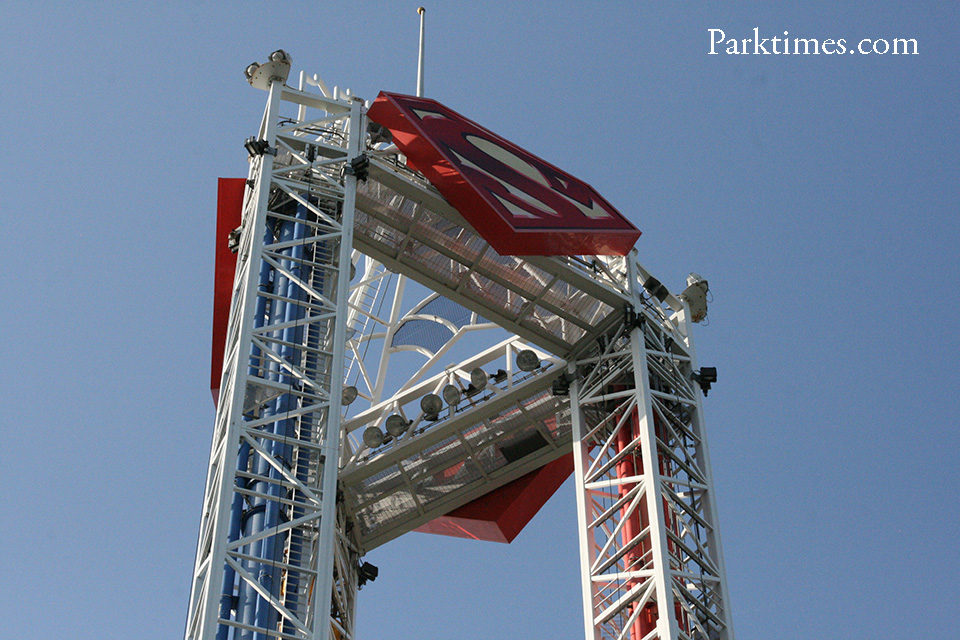
Built by S&S Power, Inc. of Logan, Utah, each one of the three legs has three sides. Each of the three sides holds three seats, for a total of twenty-seven simultaneous riders. The ride has a capacity of 1,200 riders per hour.
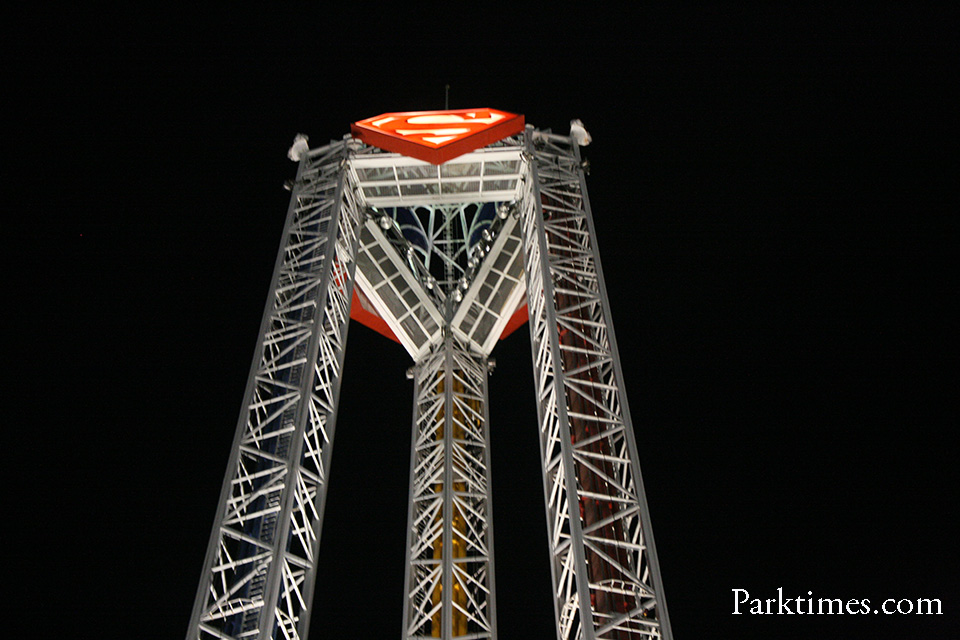
The ride seats are propelled by compressed air. Riders feel 3.5 g’s on the ascent and a negative .8 g’s on the descent. The cost of construction was estimated at over $10 million dollars.
The Superman Tower of Power was previewed with a media event on Wednesday, March 23rd, 2003. The ride officially opened to the public the following Saturday. Twelve contest winners were the initial riders for the ride’s official opening. Named for Superman, the hero of comic books, TV shows, and movies, the ride followed the park’s practice of naming rides after DC Comic characters.
A go-cart track was added for the 1999 season between the railroad tracks and the Shockwave. Riders race traditional go-carts around the winding track. The track sports forty go-carts, twenty-four of which have individual seating and sixteen of which have dual seating. Only twenty carts run on the track at any one time. Track races last four to six minutes.
The track and carts cost the park $500,000. Premier Parks installed similar tracks at nine of its 25 parks. There is a $5 up-charge to race the carts.
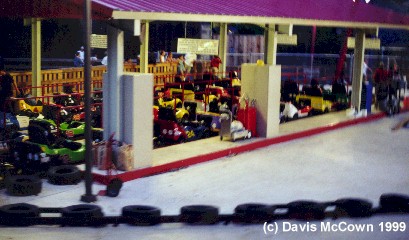
The Great Air Racer was a high swing ride installed for the 1984 season. The ride units were shaped to look like barn-storming bi-planes. Each plane was designed to hold six, with three seats, each holding two adult riders.
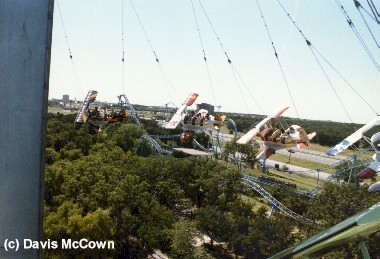
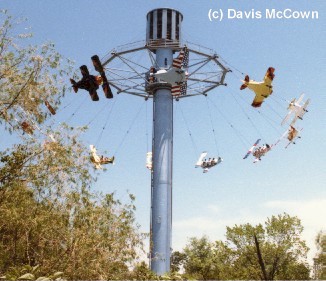
After the twelve planes were loaded, a structure rose up the middle of a large tower structure. The planes, each connected to cables, rose in the air with the structure. As the planes rose, they began to spin around the tower. Eventually, the force of the spinning planes forced them to spin further and further from the tower.
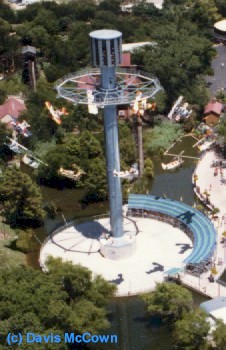
At their highest, they were nearly 100 feet off of the ground. The plans reached a spin rate of 36 miles per hour. After a few minutes of spinning, the rotation slowed and the planes began their descent back to the tarmac below them.
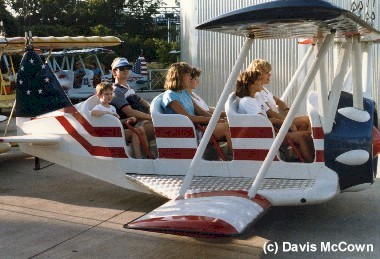
The ride was installed by Intamin and cost two million dollars. A sister ride was built at the Six Flags over Georgia park.
It was removed after the 1999 season.
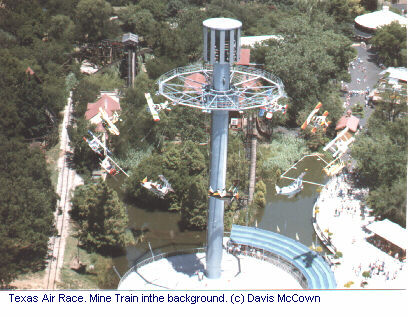
Section Tower
Year installed 1991
Last Season Operated 1991
The Hollywood Stunt Show was staged during 1991 at the Tower Theater, where it replaced the Dolphin Show. The show featured trained stuntmen performing various action scenes. There was little change in the theater for the new show. The pool itself was covered to create a large performance area, with a western town facade added at the back.
The Hollywood Stunt Show was produced by Benros Worldwide Entertainment and was staged for one year. Benros later produced Gunfight After the OK Corral and Bad Day at the Backlot stunt shows in the Texas section of the park.
In 1992, the show was replaced by the Batman Stunt Show.
In addition to producing shows in numerous other parks, Benros staged the Colossus show for Freedomland in 1961.
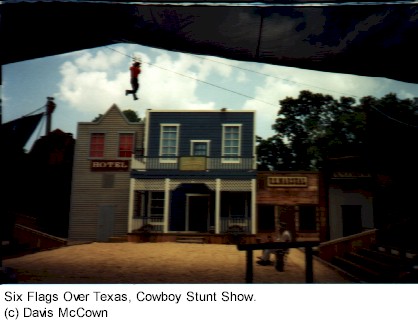
During the show, one character entered the arena using a zip line mounted on the fifty foot platform of the tower.
When it opened in 1983 the Roaring Rapids raft ride was the largest, most expensive ride ever constructed at the park. The raft ride, designed to simulate the experience of white water rafting on a raging river, is located just south of the Tower and physically takes up more space than any other ride in the park.

The ride replaced both Skull Island and LaSalle’s Riverboat Adventure, which were removed after the 1983 season to accommodate the new ride. Construction actually began August 16th, 1982, the day after the Riverboat made it last trip.
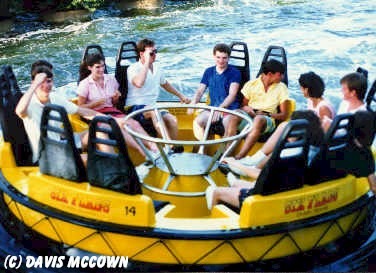
Originally, the entrance to the ride was on the north side of the ride, directly across from the exit area for the Tower. Later, the ride was renamed as LaSalle’s Rapid ride and the entrance was moved to the south side of the ride, in the same location as the former entrance to the LaSalle’s Riverboat ride.
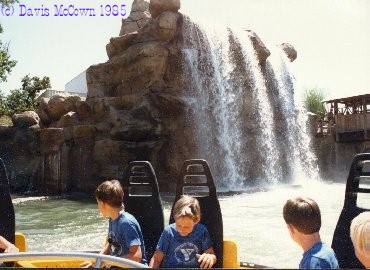
The ride was designed by Six Flags and built by Intamin A.G. at an estimated cost of $4.2 million dollars. (Intamin A.G. also built the Shockwave, Tower, and Spinnaker.)
The concept for the ride was inspired by the man-made river used for the kayak races in the 1972 Summer Olympics in Munich. The first ride of this design was built by Six Flags for the Six Flags Astroworld park and opened in 1980.

The ride constitutes of three lakes and four stretches of rapids. It is 80 feet across at its widest point and 16 feet wide at its narrowest. The “river” is filed with 1.5 million gallons of water and is powered by two 400 horsepower pumps which pump 150,000 gallons of water per minute. These are supplemented by five water jets.
The ride’s reservoir is capable of holding 2 million gallons.
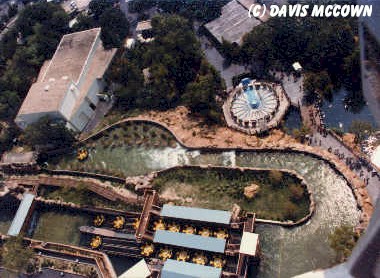
With an average water speed of 16.6 feet per second, the river grade drops 14 feet from start to finish. The 1/4 mile ride takes about 2 minutes to complete.
The ride is equipped with 20 twelve passenger boats and can carry approximately 1,200 riders per hour.
As of 1983, all six of the theme parks then owned by Six Flags operated a ride of this nature. Today, virtually ever major amusement park has a similar ride.
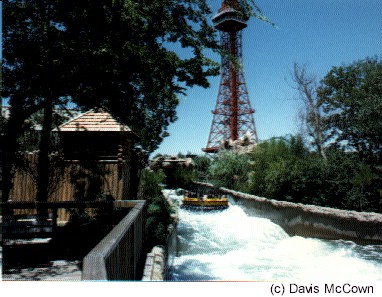
The main attraction of the original Boomtown was the 190 foot tall Sky Crane Ride. This unique ride was actually adapted from a cargo crane. The ride units consisted of two metal teardrop shaped baskets, each of which could hold 14 guests. Each was attached to a cable at the end of one of the structure’s “Y” shaped girder arms.
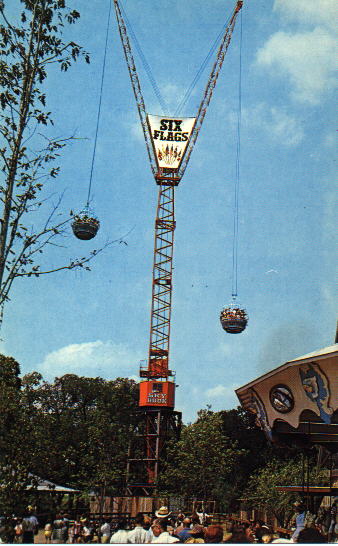
After loading, the basket was lifted up into the air. Midway up the height of the structure, the basket stopped and the entire structure rotated 180 degrees. While in that position, the basket rose again, to a total of 155 feet in the air. As the basket rose into the air, the basket on the other arm descended to be unloaded. While the other basket was unloaded and reloaded, guests in the first basket enjoyed a panoramic view of the park below them.
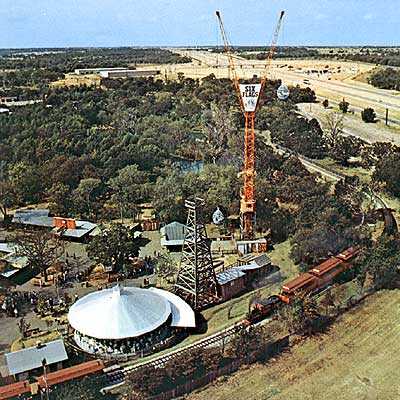
Once the other basket was loaded, it ascended halfway up as the first basket descended. At the half way point, the baskets again rotated, so that the original basket could descend to the dock and be unloaded while the guests in the second basket could enjoy the view.
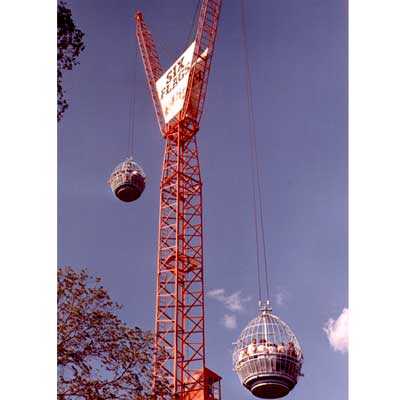
Strictly speaking, the ride was not “themed” to anything in particular in the boomtown section. It was, however, a unique experience and provided a view of the park unmatched by any ride to that date. It also provided a visual identity for the park from the freeway and surrounding area until 1968 when it was removed and replaced by the Oil Derrick as the park’s high ride.
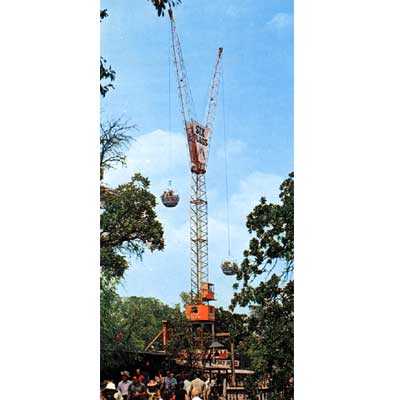
The ride itself had quite a history, having first thrilled attendees at the Brussels’ world’s fair of 1958. From there it came to Texas. After being removed from Six Flags Over Texas in 1968, the ride was dismantled and moved to Six Flags Over Georgia, where it stood as that park’s major focal point until it was sold to Magic Springs amusement park in Arkansas, where it operated for several years. It was later converted to a bungee jump platform.
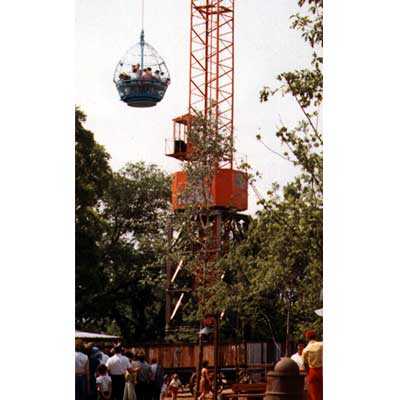
During a major remodeling of the Arkansas park it was dismantled and sold for scrap metal.
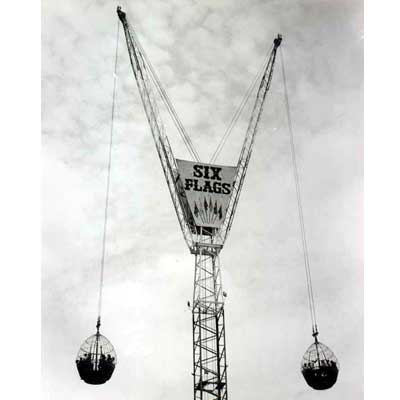

January 1, 2020 by Davis_McCown (Edit)
The Shockwave features an initial 116 foot lift, followed by a 36 degree drop into the two seventy foot loops. The one minute, fifty-eight second ride travels through 3,500 feet of track. The trains travel at up to 60 mph, with banks up to sixty degrees while the riders pull up to 5.9 g’s. Three trains of seven cars each can hold up to 28 riders. The ride capacity is 1,800 an hour.
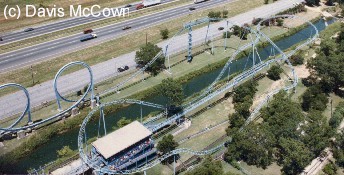
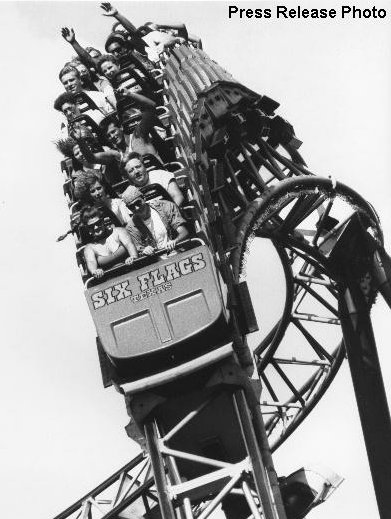
The Music Mill Theater opened in 1974 as a venue for various shows and events.
